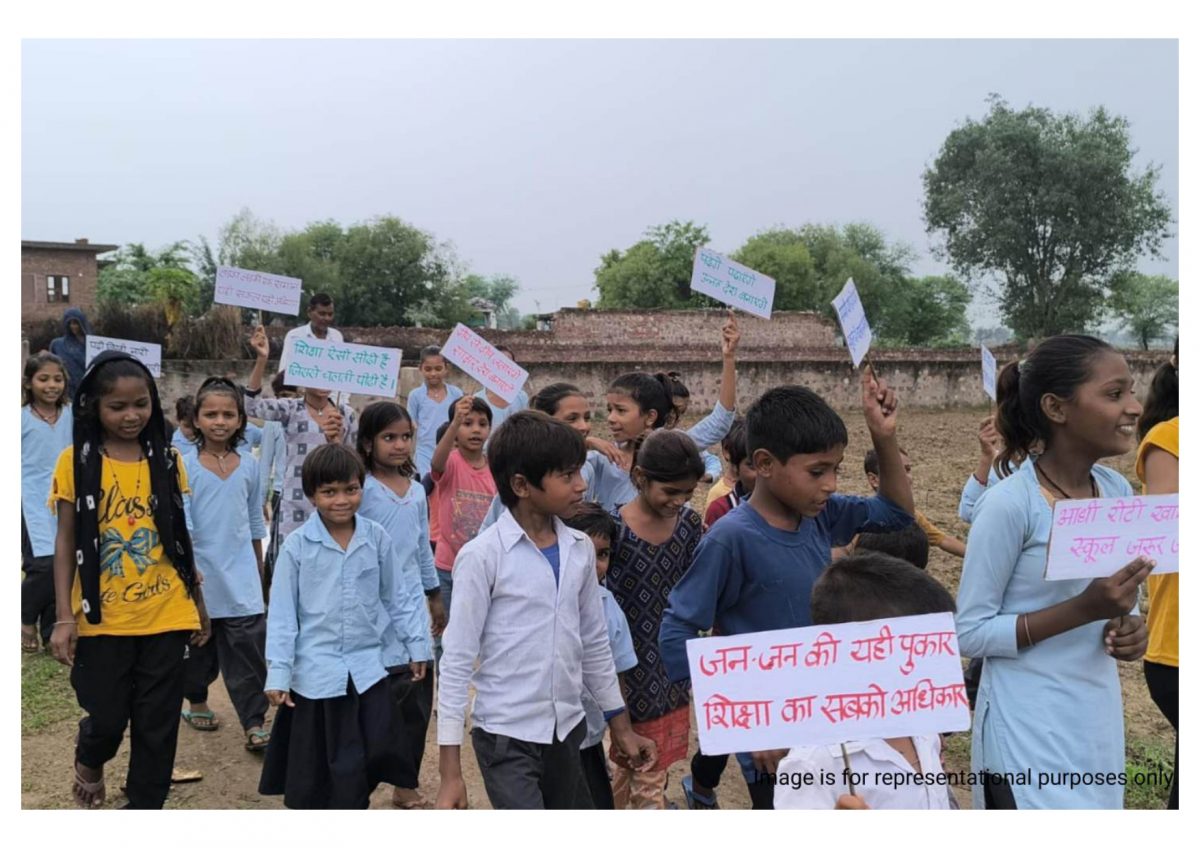From Quarries to Classrooms Bundi, Rajasthan Shows How Community-Led Initiatives Can End Child Labour
 Author: Sion Kongari
Author: Sion Kongari

(Sion Kongari leads ActionAid Association’s work in Rajasthan. The views expressed here are individual and do not necessarily reflect those of ActionAid Association.)
( “My son was going to work instead of school, but now he’s attending school, and we are happy.” – Sukhia Bhil, migrant worker, Bundi
These are the heartfelt words of Sukhia Bhil, a migrant worker from Madhya Pradesh, who travels each year to Rajasthan’s Bundi district to work in the sandstone quarries. Living in makeshift huts without electricity, toilets, or access to basic services, families like his are part of an invisible workforce—cut off from public entitlements, excluded from social safety nets, and denied access to education.
Sukhia’s son, Golu, was denied admission to the local school simply because he lacked address proof and a Bundi-based Aadhaar card. Left with no options, Golu began spending his days near the quarry, occasionally helping his parents with the heavy work. “My heart would sink… I am a father, but I couldn’t do anything,” Sukhia says.
But the turning point came when a community-based intervention led by ActionAid Association (AAA) with the support of International Labour Organisation (ILO) stepped in. Sukhia and other families learned that every child in India has a right to education—irrespective of their origin or migration status. With support, they secured temporary documentation, a migration certificate, and direct liaison with local school authorities. Golu was finally admitted to school. “Now he studies, smiles. Earlier, my son used to go to work. Now he goes to school… and we are happy,” says Sukhia with quiet pride.
Laws and Schemes to End Child Labour and Bonded Labour
Recognizing the persistence of child labour and bonded labour, the Government of India and State Governments, including the Government of Rajasthan have undertaken multiple legislative, policy, and programmatic interventions to address child labour and bonded labour, both of which are serious violations of human rights and dignity. The Child and Adolescent Labour (Prohibition and Regulation) Act, 1986, as amended in 2016, prohibits employment of children below 14 years in all occupations and adolescents (14–18 years) in hazardous occupations. The Bonded Labour System (Abolition) Act, 1976 bans all forms of bonded labour and mandates rehabilitation of those rescued. Provisions under the Bharatiya Nyaya Sanhita (BNS), 2023, Juvenile Justice Act, and Pencil Portal (Platform for Effective Enforcement for No Child Labour) support implementation and monitoring.
The National Child Labour Project (NCLP) Scheme provides rescued children with education, vocational training, and stipends through special training centres. The Central Sector Scheme for Rehabilitation of Bonded Labourers, 2016, offers financial assistance (up to ₹3 lakh), skill training, and housing support to rehabilitated bonded labourers.
The Ministry of Labour & Employment conducts awareness campaigns, and periodic inspections are carried out in collaboration with law enforcement agencies and NGOs.
The Government of Rajasthan runs NCLP centres in several districts, particularly in high-incidence areas such as Jaipur, Udaipur, and Alwar. The state has constituted District Level Task Forces to identify, rescue, and rehabilitate child and bonded labourers, often in collaboration with civil society organisations. Rescued children are enrolled in Sarva Shiksha Abhiyan schools or residential bridge courses. State Child Protection Units (SCPUs) coordinate with the education department to ensure continued schooling. Sectors like brick kilns, stone quarries, and bangle-making units have been under special scrutiny in Rajasthan due to historically high incidence of bonded and child labour.
Persistence of Child Labour and Bonded Labour
Despite these efforts, enforcement gaps, socio-economic vulnerabilities, and caste-based exploitative practices continue to pose challenges. Child labour remains entrenched in India’s informal sectors, particularly mining.
In Bundi’s sandstone quarries, child labour is often a consequence of entrenched poverty and intergenerational debt bondage. Families migrate for seasonal work and become trapped in a cycle of loans and repayments. These debts—often acquired to meet basic needs or during health emergencies—are virtually impossible to repay due to exploitative wage systems and the lack of social security.
Many of Bundi’s quarry workers are descendants of first-generation labourers who had migrated decades ago. Their family debt, often ranging from ₹50,000 to ₹2,00,000, is passed from one generation to the next. In some cases, entire families—including children—work collectively to meet daily piece-rate targets, which become the only means to earn a living wage. The work is backbreaking, and most workers begin to show signs of severe respiratory ailments like tuberculosis and silicosis by their mid-30s. Without alternative livelihoods, the burden of repaying the family’s debt falls on the children, perpetuating the cycle of labour and poverty.
Tragically, some officials seek to deny the existence of both child labour and bonded labour. As bonded labour practices are facilitated through advance payments and enforced by lack of documentation or mobility, they can remain hidden behind layers of informality and subcontracting.
The Bundi, Rajasthan Initiative
The collaboration between the Government of Rajasthan, International Labour Organisation and ActionAid Association covers 15 villages in Talera block of Bundi district. The initiative focused on eliminating child labour, promoting education, ensuring decent work for adults, and strengthening access to entitlements.
The core strength of this initiative lies in grassroots mobilisation. Through consistent village-level meetings, the programme raised awareness about labour rights and government schemes. Labour collectives were formed, peer-learning was encouraged, and local leaders were trained in occupational safety and legal rights, enabling them to become agents of change. A breakthrough was seen in the education sector. The formation of Child Rights Groups in all 15 villages created platforms for both school-going and out-of-school children. The “Yes to School” campaign re-enrolled 230 children—many from debt-burdened, migrant families—into formal education.
Recognising that poverty and debt are key drivers of child labour, the programme prioritised social protection. A total of 600 vulnerable families were identified, and 557 received access to welfare schemes Ayushman Bharat, pension plans, and more. Public grievance platforms like Jan Samvad created direct channels for communities to engage with officials, demand services, and register complaints.
To address systemic issues, the initiative also strengthened district-level institutions. Child Protection Committees (CPCs) were trained, and a District Interface Meeting brought together departments like labour, child rights, education, DCPU, CWC and police. The District Action Plan was prepared by the district administration to ensure sustained, coordinated child protection action at the district level. Efforts also included the development of a Toolkit on Safe Migration and Children in Distress, offering SOPs for frontline workers and institutions. Validated through multi-stakeholder workshops, the toolkit enables more consistent, field-informed responses to the risks faced by children in migrating or debt-bonded families.
Collaborative Initiatives Show New Hope
The Bundi initiative illustrates how community mobilisation, when aligned with institutional reform and policy advocacy, can dismantle entrenched systems of debt bondage and child labour. Addressing this issue requires more than schooling—it requires justice, dignity, and alternatives to bonded labour.
Ending child labour in sandstone quarries will not only free children from exploitative work but will also break the generational chains that have bound entire families to a life of servitude.
We hope the Bundi initiative will strengthen wider transformations. This will see Rajasthan lead not only in sandstone exports, but also in protecting the rights of those who extract it. A future where no child works and every child learns is not a dream—it is a right that must be realised.
Disclaimer: The article was originally published on down to earth.. The views expressed in the article are the author’s and do not necessarily reflect those of ActionAid Association.
